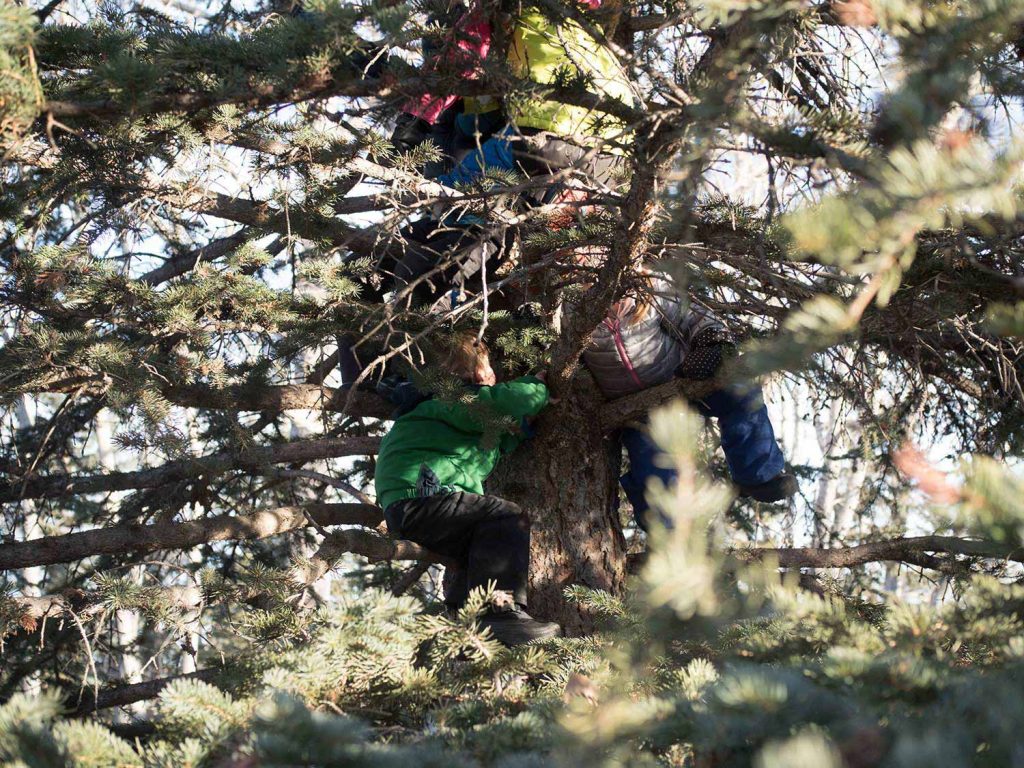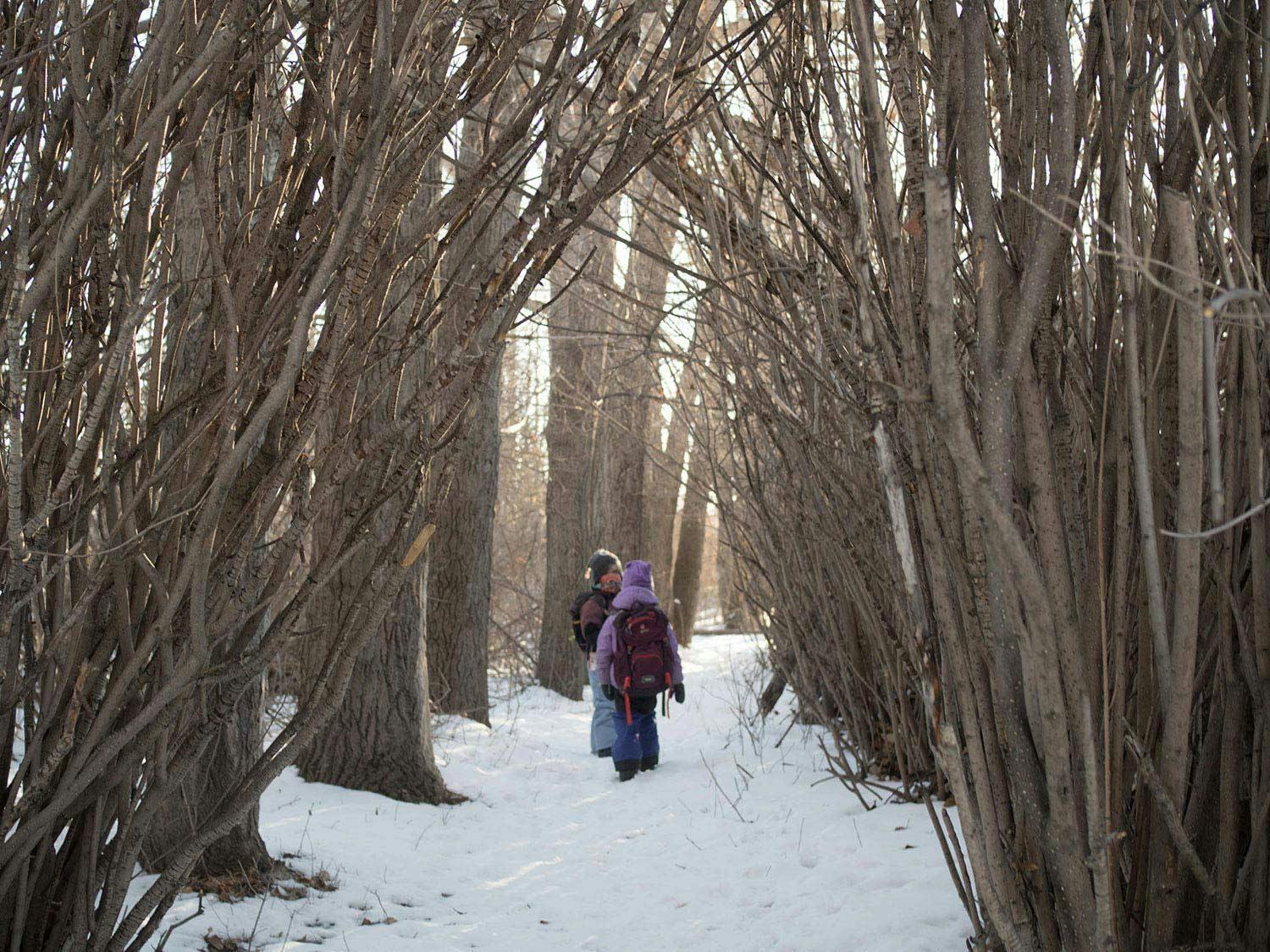Forest Schools Let Kids Play Like the Planet Depends on It
By giving our kids the opportunity to feel at home on the land, we can give the land a new generation of protectors.
At forest school, play immerses children in relationship with themselves, one another, and the environment.
“Children aren’t playing in the garden anymore; instead they’re filling in bubbles on worksheets. In the face of this indoor-ification, a cultural and educational movement is emerging — focused on new approaches to nature-based education.”
— Author and educator David Sobel
“Forest school has taught me that when we want to pick plants, their leaves or berries, we should always ask the plant for permission before we pick. If the plant says yes, we can go ahead and pick — you’ll just feel the answer from the plant, whether it’s yes or no.”
— Nala (8), student at Fresh Air Learning Elementary in North Vancouver, BC
In March, I joined my 4-year old at his forest preschool. The school operates on the grounds of a Guides camp by the Bow River — a wild break in the semi-urban landscape of our town. The first few minutes were just as I imagined: kids and big people said goodbyes, we sang a song greeting the Earth and sun, and gave ourselves a hug. But then, nothing.
Watching this gaggle of 3-to-5-year olds settle effortlessly into the winter landscape lit a fire in my heart.
I expected the teachers to give instructions, maybe outline the day. Instead, the kids led the way, scattering across a clearing like the sunlight across the snow. Some — including my son, Little Grey Lamb — found a giant log and made an improvised ladder against a tree. Some sorted through boxes of the school’s “spare parts” (pots, pans, spoons), and others plunked themselves down to smell the snowflakes.
Of course, all this independence was a delicately facilitated facade; the teachers had tabs on each child, and these interests had been honed over weeks of place-based, inquiry-driven education. But watching this gaggle of 3-to-5-year olds settle effortlessly into the winter landscape lit a fire in my heart.
Smiling into the sun, I couldn’t help but wonder: could this be our next generation of environmental avengers?

Forest school often just looks like kids playing in the trees.
To be honest, forest school often just looks like kids playing in the trees (or snow, mud, grass, or tundra); in fact, that play immerses children in relationship with themselves, one another, and the environment. Originating in Scandinavia, forest schools have existed for over 50 years, and been adapted to different cultural contexts. They can operate in any natural environment, the philosophy just requires students to spend regular, repeated time in the same spaces; anywhere from 70–100% of each day can be spent outdoors.
Lori Toma, co-founder of Little Grey’s school, Growing Roots Forest Play says, “The role that we play in nature, the role that we play in the space — we talk about it all the time. When we’re talking about the wild animals we see, [the kids] are very aware that this isn’t our space first, that the animals are sharing it with us.”
I get a lot of questions about our choice of school: How will he learn his letters? What if he never adapts to sitting at a desk? I’m not worried — these things can be worked in through teachable moments like counting ladybugs on a branch. Truthfully, I’m more concerned about his future in a changing climate. To navigate what comes next, he’ll need resilience, self-awareness, and critical thinking. And our planet will need empathetic, courageous people who aren’t afraid to get their hands dirty in the fight to protect our home.
Little Grey’s teachers tell me he knows more about the natural environment than the average 4-year-old — and this makes me prouder than if he could already write his name. But the relationship I hope my kids develop with the Earth goes beyond understanding food chains and identifying moose tracks. I hope they develop a sense of empathy and ecological identity.
While the term may sound dry and academic, “ecological identity” is what develops when we take our place between the pine trees and the porcupines. It’s the feeling of being at home in the natural environment — and it cultivates our desire to look after it.
I get a lot of questions about our choice of school: How will he learn his letters? Truthfully, I’m more concerned about his future in a changing climate.
Elizabeth Boileau is a PhD student at Lakehead University in Ontario, researching Canadian nature schools. While her work hasn’t yet connected all the dots between forest schools and ecological identity, she believes these programs help students develop values that are “eco-centric, as opposed to anthropocentric. So later on in life, [children will be] looking at the natural world as if they are part of it, and it’s not something for us just to use to our benefit until there’s nothing left.”
Parents of forest school kids don’t need research to confirm the power of these programs. Kate Coghlan, for example, says one of her favourite things about her now-5-year-old daughter’s experience at Langley Forest School in BC, “was the sense of connection children felt to the environment, animals, park, streams, and everything around them… I believe that this sense of connection helps children grow into people who are more caring about the environment.”
Even though most of them probably didn’t go to forest school, this kind of connection and concern led 16-year old Greta Thunberg and over 1 million other young people to take to the streets in March, and will continue to fuel their fight. Indeed, research out of Cornell suggests early experiences with the natural world can lead to future environmental activism or involvement. By giving our kids the ability to be in relationship with the land, we’re hopefully also giving the land a new generation of protectors.
All that said, I’ve spent much of my adult life involved in outdoor education, and am keenly aware of the industry’s shortcomings. Forest school programs are mostly available to the privileged: they can be financially inaccessible to the majority of North American families, except in the rare cases they’re offered in the public system or as co-ops.
Schools must also grapple with the fact that they exist on Indigenous land, and operate within an education system badly in need of decolonizing. And in the words of academics Eve Tuck and K. Wayne Yang: “Decolonization is not a metaphor.” It isn’t nearly as simple as honouring Indigeneity through stories, lessons, or activities. There is no script, no land acknowledgment, no settler-created curriculum that can fix this.
While grownups have work to do on these fronts, our kids are busy playing like the planet depends on it. Their imaginations thrive in these immersive programs, and they become rooted in a sense of place.
Schools must also grapple with the fact that they exist on Indigenous land, and operate within an education system badly in need of decolonizing.
Michelle Goulet Barteaux, the founder of Wild Child Alternative Education outside Calgary, tells me about Rainbow Ridge, a meaningful place for her forest school students: “There’s construction coming, and I think Rainbow Ridge is one of the places that’s slated for burn… And that’s going to matter to [the students] — if they didn’t love this space, if we hadn’t lived there and occupied that space, they would probably be more interested in seeing the diggers.”
I’m only too happy to comb the grass from Little Grey’s hair and pick the sticks from his pockets, knowing he and his classmates are learning to care more for deer tracks than diggers. It’s easy to feel despondent about the planet’s future, and maybe that despair will lead us to planetary action — but today, I’m taking solace in the power of play, kids climbing trees, and spare parts.
Print Issue: Summer/Fall 2019
